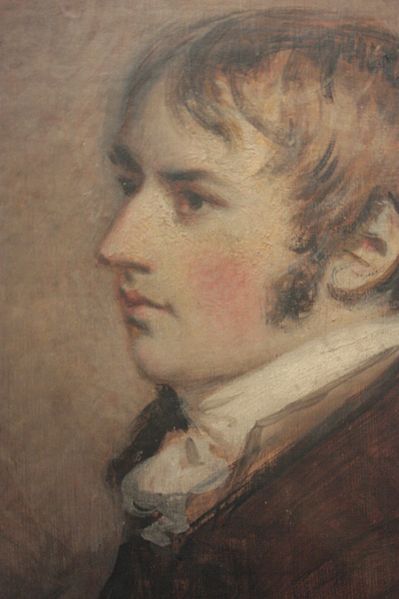
Born: 11 June 1776, London
Died: 31 March 1837 (aged 60)
Period: Romanticism
The Life of John Constable
John Constable was one of the foremost British landscape painters of the 19th century, known for his remarkable ability to capture the beauty of the English countryside, particularly his native Suffolk. Constable’s work is characterized by its detailed observation of nature and the sky, his use of vibrant, naturalistic colors, and his innovative techniques in capturing the changing patterns of light and atmosphere.
Born in East Bergholt, Suffolk, Constable was the son of a wealthy mill owner, but he pursued his passion for art against his family’s wishes. In 1799, he enrolled at the Royal Academy Schools in London, where he studied the works of the old masters and honed his skills in drawing and painting. Despite this formal training, Constable never left Britain to study art in Europe, as many of his contemporaries did, preferring instead to find inspiration in his local surroundings.
Constable’s early work focused on landscape sketches and paintings, but it wasn’t until his mature years that he developed the distinctive style for which he is known. He famously said, “I should paint my own places best,” and his most celebrated works are indeed depictions of the English countryside, full of emotional depth and realism. He sought to capture the dynamic nature of the landscape, often painting en plein air (outdoors) to directly observe his subjects.
One of Constable’s most iconic works is “The Hay Wain” (1821), which depicts a rural scene on the River Stour near his home and is celebrated for its depiction of natural beauty and rural life. Despite the high regard we hold for Constable today, recognition in his own time was limited, and he struggled for much of his life to gain acceptance in the British art establishment. It was only in France that he received significant acclaim during his lifetime, influencing the Barbizon School and the subsequent Impressionist movement with his techniques and approach to landscape painting.
Constable was deeply committed to portraying the landscape authentically, often contrasting the peaceful countryside with the dramatic and changing English skies. His dedication to studying and painting nature contributed significantly to the development of landscape painting in the 19th century. Though he sold relatively few paintings and was not fully appreciated until after his death, today Constable is celebrated as a key figure in the Romantic movement and one of the greatest British landscape artists, whose works continue to inspire admiration for their profound beauty and emotive power.
John Constable’s Notable Works
John Constable was a pivotal figure in landscape painting, known for his richly detailed and emotive depictions of the English countryside. Here are ten of his most famous and celebrated works:
- The Hay Wain (1821) – Perhaps Constable’s most famous painting, it depicts a rural scene on the River Stour near Flatford Mill. The work is renowned for its depiction of natural beauty and serene landscape, capturing the essence of the English countryside.
- Dedham Vale (1802) – Often referred to as “The Valley of the River Stour,” this painting is an early example of Constable’s landscapes, showing the area where he grew up. It beautifully captures the calmness and beauty of the Suffolk countryside.
- The Cornfield (1826) – Another quintessential Constable, this painting shows a country path leading through a field, with a shepherd and his flock under the shade of large trees. The attention to light and texture is particularly notable.
- Salisbury Cathedral from the Meadows (1831) – This dramatic landscape, featuring the iconic cathedral under a brooding sky, is part of Constable’s series of paintings that sought to capture the grandeur of this medieval church.
- Flatford Mill (Scene on a Navigable River) (1816-1817) – Part of a series that includes “The Hay Wain,” this painting features the working life of the River Stour in Suffolk, showcasing Constable’s love for his native landscape.
- Wivenhoe Park, Essex (1816) – Commissioned by Major General Francis Slater-Rebow, this painting depicts the parkland of his estate, showcasing Constable’s skill in capturing the reflective surfaces of water and the varied textures of foliage.
- The Lock (1824) – Part of the series of six foot canvases depicting scenes on the Stour, this painting illustrates a lock keeper opening the gates for a boat, emphasizing the interaction between man and nature.
- The White Horse (1819) – The first of Constable’s six-foot canvases, it shows a barge (specifically, a lighter) making its way up the River Stour, a scene reflective of the changing rural landscape of England.
- Boat-building near Flatford Mill (1815) – This painting captures a scene of rural industry, showing men constructing a boat by the river, underscoring Constable’s interest in depicting everyday life in the countryside.
- Stonehenge (1835) – One of Constable’s later works, this dramatic painting of the ancient monument under turbulent skies reflects his ongoing fascination with weather and atmosphere, alongside a deeper, perhaps more contemplative approach to the landscape.
John Constable’s work is celebrated for its innovative approach to landscape painting, emphasizing natural beauty, light, and atmosphere, and these works exemplify his contribution to art and his lasting legacy.